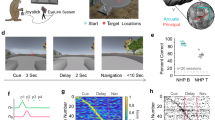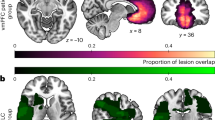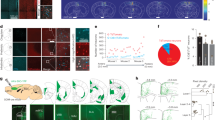Abstract
The prefrontal cortex is important in guiding or inhibiting future responses, which requires the temporal integration of events and which provides continuity to the thought process. No cellular mechanism has been proposed to explain how the mental representation of a response or idea is linked to the next. Using simultaneous recordings in monkeys, we revealed inhibitory interactions between neurons active at different time points relative to the cue presentation, delay interval and response period of a working memory task. These findings suggest an important role of inhibition in the cerebral cortex—controlling the timing of neuronal activities during cognitive operations and thereby shaping the temporal flow of information.
This is a preview of subscription content, access via your institution
Access options
Subscribe to this journal
Receive 12 print issues and online access
$209.00 per year
only $17.42 per issue
Buy this article
- Purchase on Springer Link
- Instant access to full article PDF
Prices may be subject to local taxes which are calculated during checkout





Similar content being viewed by others
References
Ben-Yishai, R., Bar-Or, R. L. & Sompolinsky, H. Theory of orientation tuning in visual cortex. Proc. Natl. Acad. Sci. USA 92, 3844–3848 (1995).
Somers, D. C., Nelson, S. B. & Sur, M. An emergent model of orientation selectivity in cat visual cortical simple cells. J. Neurosci. 15, 5448–5465 (1995).
Troyer, T. W., Krukowski, A. E., Priebe, N. J. & Miller, K. D. Contrast-invariant orientation tuning in cat visual cortex: thalamocortical input tuning and correlation-based intracortical connectivity. J. Neurosci. 18, 5908–5927 (1998).
Ferster, D. & Miller, K. D. Neural mechanisms of orientation selectivity in the visual cortex. Annu. Rev. Neurosci. 23, 441–471 (2000).
McLaughlin, D., Shapley, R., Shelley, M. & Wielaard, D. J. A neuronal network model of macaque primary visual cortex (V1): orientation selectivity and dynamics in the input layer 4Cα. Proc. Natl. Acad. Sci. USA 97, 8087–8092 (2000).
Wang, Y., Fujita, I. & Murayama, Y. Neuronal mechanisms of selectivity for object features revealed by blocking inhibition in inferotemporal cortex. Nat. Neurosci. 3, 807–813 (2000).
Rao, S. G., Williams, G. V. & Goldman-Rakic, P. S. Destruction and creation of spatial tuning by disinhibition: GABA(A) blockade of prefrontal cortical neurons engaged by working memory. J. Neurosci. 20, 485–494 (2000).
Goldman-Rakic, P. S. Topography of cognition: parallel distributed networks in primate association cortex. Annu. Rev. Neurosci. 11, 137–156 (1988).
Fuster, J. M. The prefrontal cortex and its relation to behavior. Prog. Brain. Res. 87, 201–211 (1991).
Funahashi, S., Bruce, C. J. & Goldman-Rakic, P. S. Mnemonic coding of visual space in the monkey's dorsolateral prefrontal cortex. J. Neurophysiol. 61, 331–349 (1989).
Funahashi, S., Bruce, C. J. & Goldman-Rakic, P. S. Visuospatial coding in primate prefrontal neurons revealed by oculomotor paradigms. J. Neurophysiol. 63, 814–831 (1990).
Funahashi, S., Bruce, C. J. & Goldman-Rakic, P. S. Neuronal activity related to saccadic eye movements in the monkey's dorsolateral prefrontal cortex. J. Neurophysiol. 65, 1464–1483 (1991).
Fuster, J. M. Prefrontal cortex and the bridging of temporal gaps in the perception–action cycle. Ann. NY Acad. Sci. 608, 318–329; discussion 330–336 (1990).
Fuster, J. M. The prefrontal cortex, mediator of cross-temporal contingencies. Human Neurobiology 4, 169–179 (1985).
Fuster, J. M., Bodner, M. & Kroger, J. K. Cross-modal and cross-temporal association in neurons of frontal cortex. Nature 405, 347–351 (2000).
Perkel, D. H., Gerstein, G. L. & Moore, G. P. Neuronal spike trains and stochastic point processes. II. Simultaneous spike trains. Biophys. J. 7, 419–440 (1967).
Fetz, E. E., Toyama, K. & Smith, W. in Cerebral Cortex, Volume 9 (ed. Peters, A.) 1–47 (Plenum, New York, 1991).
Reid, R. C. & Alonso, J. M. Specificity of monosynaptic connections from thalamus to visual cortex. Nature 378, 281–284 (1995).
Aertsen, A. M., Gerstein, G. L., Habib, M. K. & Palm, G. Dynamics of neuronal firing correlation: modulation of “effective connectivity”. J. Neurophysiol. 61, 900–917 (1989).
Constantinidis, C., Franowicz, M. N. & Goldman-Rakic, P. S. Coding specificity in cortical microcircuits: a multiple electrode analysis of primate prefrontal cortex. J. Neurosci. 21, 3646–3655 (2001).
Nowak, L. G., Munk, M. H., Nelson, J. I., James, A. C. & Bullier, J. Structural basis of cortical synchronization. I. Three types of interhemispheric coupling. J. Neurophysiol. 74, 2379–2400 (1995).
Gibson, J. R., Beierlein, M. & Connors, B. W. Two networks of electrically coupled inhibitory neurons in neocortex. Nature 402, 75–79 (1999).
Beierlein, M., Gibson, J. R. & Connors, B. W. A network of electrically coupled interneurons drives synchronized inhibition in neocortex. Nat. Neurosci. 3, 904–910 (2000).
Vaadia, E. et al. Dynamics of neuronal interactions in monkey cortex in relation to behavioural events. Nature 373, 515–518 (1995).
Riehle, A., Grun, S., Diesmann, M. & Aertsen, A. Spike synchronization and rate modulation differentially involved in motor cortical function. Science 278, 1950–1953 (1997).
Oram, M. W., Hatsopoulos, N. G., Richmond, B. J. & Donoghue, J. P. Excess synchrony in motor cortical neurons provides redundant direction information with that from coarse temporal measures. J. Neurophysiol. 86, 1700–1716 (2001).
Elhanany, E. and White, E.L. Intrinsic circuitry: synapses involving the local axon collaterals of corticocortical projection neurons in the mouse primary somatosensory cortex. J. Comp. Neurol. 291, 43–54 (1990).
Melchitzky, D. S., Sesack, S. R., Pucak, M. L. & Lewis, D. A. Synaptic targets of pyramidal neurons providing intrinsic horizontal connections in monkey prefrontal cortex. J. Comp. Neurol. 390, 211–224 (1998).
Krimer, L. S. & Goldman-Rakic, P. S. Prefrontal microcircuits: membrane properties and excitatory input of local, medium, and wide arbor interneurons. J. Neurosci. 21, 3788–3796 (2001).
Goldman-Rakic, P. S. Cellular basis of working memory. Neuron 14, 477–485 (1995).
Funahashi, S., Chafee, M. V. & Goldman-Rakic, P. S. Prefrontal neuronal activity in rhesus monkeys performing a delayed anti-saccade task. Nature 365, 753–756 (1993).
Constantinidis, C., Franowicz, M. N. & Goldman-Rakic, P. S. The sensory nature of mnemonic representation in the primate prefrontal cortex. Nat. Neurosci. 4, 311–316 (2001).
Dehaene, S. & Changeux, J. P. A hierarchical neuronal network for planning behavior. Proc. Natl. Acad. Sci. USA 94, 13293–13298 (1997).
Changeux, J. P. & Dehaene, S. Hierarchical neuronal modeling of cognitive functions: from synaptic transmission to the Tower of London. Int. J. Psychophysiol. 35, 179–187 (2000).
Amit, D. J. & Brunel, N. Model of global spontaneous activity and local structured activity during delay periods in the cerebral cortex. Cereb. Cortex 7, 237–252 (1997).
Lisman, J. E., Fellous, J. M. & Wang, X. J. A role for NMDA-receptor channels in working memory. Nat. Neurosci. 1, 273–275 (1998).
Camperi, M. & Wang, X. J. A model of visuospatial working memory in prefrontal cortex: recurrent network and cellular bistability. J. Comput. Neurosci. 5, 383–405 (1998).
Compte, A., Brunel, N., Goldman-Rakic, P. S. & Wang, X. J. Synaptic mechanisms and network dynamics underlying spatial working memory in a cortical network model. Cereb. Cortex 10, 910–923 (2000).
Guigon, E., Dorizzi, B., Burnod, Y. & Schultz, W. Neural correlates of learning in the prefrontal cortex of the monkey: a predictive model. Cereb. Cortex 5, 135–147 (1995).
Gao, W.-J., Krimer, L.S. and Goldman-Rakic, P.S. Presynaptic regulation of recurrent excitation by D1 receptors in prefrontal circuits. Proc. Natl. Acad. Sci. USA 98, 295–300 (2001).
Rao, S.G., Williams, G.V. & Goldman-Rakic, P.S. Isodirectional tuning of adjacent interneurons and pyramidal cells during working memory: evidence for microcolumnar organization in PFC. J. Neurophysiol. 81, 1903–1916 (1999).
Wilson, F.A.W., O'Scalaidhe, S.P. & Goldman-Rakic, P.S. Dissociation of object and spatial processing domains in primate prefrontal cortex. Science 260, 1955–1958 (1993).
Acknowledgements
We wish to thank S. Rao and M. Franowicz, who participated in these experiments. This research was supported by NIH grant MH38546 to P.S.G.-R. and a McDonnell-Pew Program in Cognitive Neuroscience Award to C.C.
Author information
Authors and Affiliations
Corresponding author
Ethics declarations
Competing interests
The authors declare no competing financial interests.
Rights and permissions
About this article
Cite this article
Constantinidis, C., Williams, G. & Goldman-Rakic, P. A role for inhibition in shaping the temporal flow of information in prefrontal cortex. Nat Neurosci 5, 175–180 (2002). https://doi.org/10.1038/nn799
Received:
Accepted:
Published:
Issue Date:
DOI: https://doi.org/10.1038/nn799



